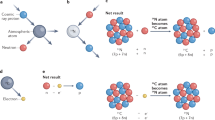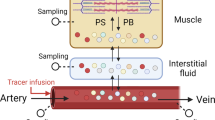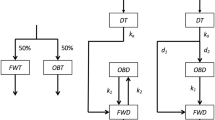Abstract
OBJECTIONS have been raised against the use of radioactive indicators in physiology, suggesting two sources of error, namely, a discriminating effect for isotopic atoms, and a change in the behaviour of organic material through irradiation1. Although one has good theoretical reasons to believe that the radioactive tracer atoms and their non-active isotopes show the same physico-chemical behaviour2, and that effects of irradiation could be neglected so long as the specimens are not too active3, it has been emphasized2 that doubts about the tracer method can only be removed by experimental evidence.
This is a preview of subscription content, access via your institution
Access options
Subscribe to this journal
Receive 51 print issues and online access
$199.00 per year
only $3.90 per issue
Buy this article
- Purchase on Springer Link
- Instant access to full article PDF
Prices may be subject to local taxes which are calculated during checkout
Similar content being viewed by others
References
Barnett, A., Phys. Rev., 56, 963 (1939).
Crane, H. R., ibid., 56, 1234 (1939).
Mullins, Lorin J., ibid., 56, 1244 (1939), Hevesy, G., ibid., 57, 240 (1940).
Brewer, A. Keith, Ind. and Eng. Chem., 30, 893 (1938).
Lasnitzki, A., and Brewer, A. K., NATURE, 142, 538 (1938).
Livingood, J. J., and Seaborg, G. T., Rev. Mod. Phys., 12, 30 (1940).
Author information
Authors and Affiliations
Rights and permissions
About this article
Cite this article
BLÜH, O. Mixed Radioactive Indicators in Physiological Experiments. Nature 146, 233–234 (1940). https://doi.org/10.1038/146233a0
Issue Date:
DOI: https://doi.org/10.1038/146233a0
Comments
By submitting a comment you agree to abide by our Terms and Community Guidelines. If you find something abusive or that does not comply with our terms or guidelines please flag it as inappropriate.



